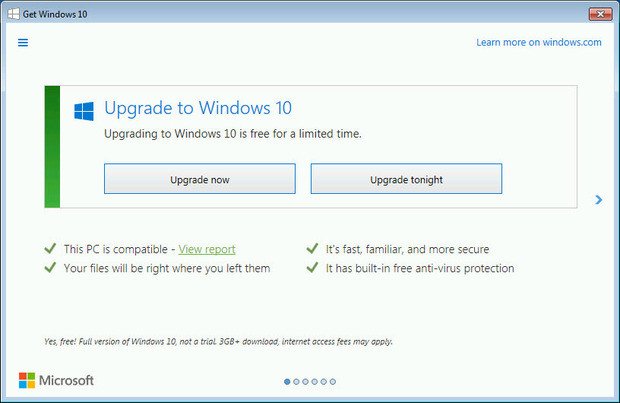A recent entry on Microsoft’s Windows blog made it into headlines everywhere last week. In the blog entry titled “Windows 10 Embracing Silicon Innovation“, Terry Myerson – Executive Vice President, Windows and Devices Group stated that Microsoft is working with manufacturers to bring next generation of Windows 10 devices.
While this sounds like users will soon see new devices designed to make the most out of Windows 10, it also means that in its continued desperation to promote (push) Windows 10, Microsoft is moving away from previous operating systems Windows 7 and Windows 8.1.
According to the new support policy, the next-generation Intel, AMD, and Qualcomm processors will not support Windows 7 or 8.1. Which means users who purchase new PCs will have to use Windows 10 only.
Going forward, as new silicon generations are introduced, they will require the latest Windows platform at that time for support.”- explains Terry. “This enables us to focus on deep integration between Windows and the silicon, while maintaining maximum reliability and compatibility with previous generations of platform and silicon. For example, Windows 10 will be the only supported Windows platform on Intel’s upcoming “Kaby Lake” silicon, Qualcomm’s upcoming “8996” silicon, and AMD’s upcoming “Bristol Ridge” silicon.
What this simply means is that Microsoft is pushing Windows 10 to users too hard. More than 200 million devices are currently running Windows 10. While this is a big figure, Microsoft expected the adoption to be much higher. Microsoft anticipated 1 billion Windows 10 devices at the time of its launch and is falling short to achieve that figure.
Windows 10: Upgrade Now or Upgrade Tonight. What about Upgrade Never?
Ever since its launch, Microsoft has been pushy and way too enthusiastic about Windows 10. First they started pushing Windows 10 to Windows 7 and 8/8.1 users even if they didn’t ask for it. Most recently, Microsoft started showing nagging and rather intrusive ‘Upgrade now or upgrade tonight’ screen. Downloading large files without user ever asking for it, repetitive upgrade notifications and things like ‘upgrade now or upgrade tonight’ is something what Microsoft calls as “good customer experience.” This might be Microsoft’s definition of good customer experience but such move shows its (over)enthusiasm and how desperately it wants users to make a transition to Windows 10.

Coming back to new announcement, the new policy doesn’t change the actual support cycle of Windows 7 or 8.1, which are going to receive support till January 2020 and January 2023 respectively. But users of next-generation hardware will no longer have the option to run older Windows versions.
Windows 10: You Have 18 Months to Upgrade, or Lose Support
Users including enterprises who own 6th generation Intel processors and running Windows 7 or 8.1, will have 18 months to upgrade to Windows 10. After July 17, 2017, only the ‘most critical’ security patched will be delivered for this combination. Also, these patches will only be made available if they don’t ‘risk the reliability or compatibility’ of Windows 7 and 8.1 on other (non-Skylake) systems.
Microsoft says it will be maintaining a list of approved Skylake systems which will receive ‘guaranteed’ Windows 7 and 8.1 support through July 17th, 2017. It means enterprises have 18 months to buy new hardware and get used to Windows 10.
We know many of these customers continue to rely on Windows 7 for its well understood reliability and compatibility. Windows 7 was designed nearly 10 years ago before any x86/x64 SOCs existed. For Windows 7 to run on any modern silicon, device drivers and firmware need to emulate Windows 7’s expectations for interrupt processing, bus support, and power states- which is challenging for WiFi, graphics, security, and more. As partners make customizations to legacy device drivers, services, and firmware settings, customers are likely to see regressions with Windows 7 ongoing servicing.
Enterprises usually stick to a stable OS for a number of reasons. Compatibility and dependency issues are among the top reasons why it takes time for corporations to upgrade to latest OS. Given the 18-month grace period, corporations will need to work on solving those issues and upgrade to Windows 10.
It looks like Microsoft desperately wants users to adopt Windows 10 by any mean necessary. In previous years, users had to ‘upgrade’ their hardware in order to use latest Windows OS. Now the scene has changed and newer hardware will no longer be capable of running older operating systems.
A Smart Move by Microsoft
Newer generation of chips are introducing features which didn’t exist in the era of Windows 7. Microsoft is choosing not to invest time, money and efforts into making these features compatible with Windows 7 and rather looks forward to improve Windows 10. As far as Windows 8.1 is concerned, it only has about 10% market-share. Looking at the features, improvements and stability Windows 10 provides, Windows 8.1 users would not have issues with upgrading. Windows 7 is not being sold in retail market so new users will not go for it. Which leaves only one choice in hand- Windows 10.
Microsoft has made a smart move by indirectly ‘forcing’ users into using Windows 10. Now with the help of manufacturers, it will become easier for Microsoft to reach the billion mark.
Is it okay for Microsoft to be pushy? Is Windows 10 worth the push? How will new support policy affect the market and users? Share your thoughts below.
Support Me: If this article/tutorial helped you today, please consider supporting me and help me run frunction.com
